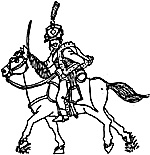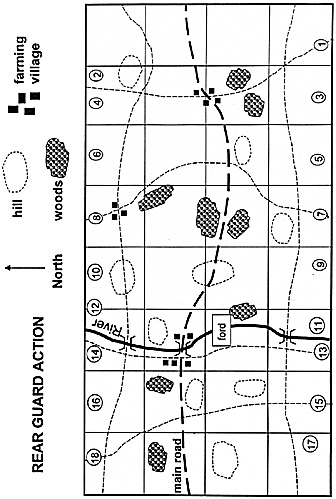 I started thinking about this scenario while reading Bernard Cornwell’s Sharpe’s Rifles. The retreat from Corunna inspired my thoughts. How does a rear guard keep the pursuers away from a withdrawing army? The general scenario is as follows. A British army is on a long withdrawal after a pretty serious mauling. The organized battalions and squadrons are in the front, followed by a long, slow procession of baggage and supply wagons, the walking wounded, stragglers, and, in my scenario, a large battery of siege artillery. This mixed bag bringing up the rear, is protected by a few companies of infantry walking slowly alongside the supply wagons and guns. It is also protected by a rear guard whose purpose is to prevent large bodies of enemy from coming into contact with the withdrawing formations.
I started thinking about this scenario while reading Bernard Cornwell’s Sharpe’s Rifles. The retreat from Corunna inspired my thoughts. How does a rear guard keep the pursuers away from a withdrawing army? The general scenario is as follows. A British army is on a long withdrawal after a pretty serious mauling. The organized battalions and squadrons are in the front, followed by a long, slow procession of baggage and supply wagons, the walking wounded, stragglers, and, in my scenario, a large battery of siege artillery. This mixed bag bringing up the rear, is protected by a few companies of infantry walking slowly alongside the supply wagons and guns. It is also protected by a rear guard whose purpose is to prevent large bodies of enemy from coming into contact with the withdrawing formations.
The withdrawing units follow a single road and move at one-half speed. I represented the withdrawing column by a marker for the last element in the column and each turn the marker progressed a small distance further along. The goal of the rear guard is to protect the column until it exits the wargame table. The purpose of the French pursuers is to cut the column. In this game, I play the rear guard while the French are automated.
Order of Battle
British Rear Guard
Battalion of rifles 30 figures
Battalion of Light Infantry 30 figures
Battalion of Fusiliers 30 figures
Regiment of Hussars 12 figures
Regiment of Light Dragoons 12 figures
2 batteries of horse artillery 2 guns per battery
French Pursuers
The actual composition of pursuing forces depends on a die roll but will consist of:
Light Infantry battalions 36 figures
Line Infantry battalions 36 figures
Hussar regiments 16 figures
Dragoon regiments 16 figures
Foot and horse artillery two guns per battery
In my rules, light infantry and rifles move faster than line infantry or fusiliers and this makes you think of where to best employ your forces.
Game Table
In this game, I use my 4 foot by 8 foot wargame table. I have a main road generally along the center of the long axis. The withdrawing column must stay on this road moving from east to west. There are roads parallel to and intersecting this main road. Sprinkled about are small wooded areas and low hills. Cutting the table is a river crossed by bridges at the roads and at a couple of fords elsewhere. Along the long edges of the board are numbered locations which mark the entry points of the French pursuers.
Game Mechanics
Everyone has his favorite rules. Mine are homegrown. Choose any tactical level horse and musket rules that allow you to fight units smaller than battalion size.
I start my game with the marker on the eastern edge of the table on the main road. I divide the rear guard into two balanced forces and place units on hills and in woods to cover the approaches to the main road.
Turn sequence:
Move marker 1/2 infantry column move westward.
Roll to see if French pursuers appear on the table this turn.
If French appear, roll to determine where.
Then roll to determine composition of French force.
French turn.
British turn.
Morale rolls
In my rules, the marker moves 3 inches each turn which means it takes at least 26 turns for the withdrawing column to exit the table. However, if the French are sitting on the main road between the marker and the western edge of the table, they have cut the road and the marker does not move forward as long as the road is cut.
The French appear on a roll if 5 or 6 on a 1D6. If they do not appear, start the next turn. You must keep track of what turn it is because this determines where the French appear.
The French appear at the marked entry point according to a die roll. Numbers are added to the die roll depending on the turn. This ensures that the French are somewhere on the flank of the withdrawing column and forces the rear guard to keep moving as the column moves.
| Turn | Add to die roll | Turn | Add to die roll | Turn | Add to die roll |
|---|---|---|---|---|---|
| 1 | 0 | 11 | 4 | 21 | 8 |
| 2 | 0 | 12 | 4 | 22 | 8 |
| 3 | 1 | 13 | 5 | 23 | 9 |
| 4 | 1 | 14 | 5 | 24 | 9 |
| 5 | 2 | 15 | 5 | 25 | 10 |
| 6 | 2 | 16 | 6 | 26 | 10 |
| 7 | 2 | 17 | 6 | 27 | 11 |
| 8 | 3 | 18 | 7 | 28 | 11 |
| 9 | 3 | 19 | 7 | 29 | 12 |
| 10 | 4 | 20 | 7 | 30 | 12 |
Once the entry point of the French force is located, next determine the composition of that force. Roll 1D6 and refer to the following table.
Roll
1 1/2 of a battalion of light infantry
2 A battalion of light infantry
3 A battalion of line infantry
4 A battalion of line infantry and foot battery
5 1/2 regiment of hussars and a horse battery
6 A regiment of dragoons
Now, the central question of solo wargaming comes into play “How do I automate the behavior of a force?” Well, in this game it is fairly easy. The French force will immediately move toward the main road to cut it westward of the moving marker. They will attempt to fight past any British in their immediate path. This means that if there is a British force in a woods or on a hill within musket range, the French will attack. If entering the table west of the river, the French move to block any bridges or fords that will be used by the withdrawing column or the rear guard. The French always move to cut the road unless forced into retreat or withdrawal by morale failures.
The withdrawing column offers the French no resistance. Only the rear guard can push the French off the main road. The French unit stays on the main road, moving westward toward the nearest defendable terrain, and resists the rear guard to the utmost. If the British withdraw or retreat, they do so toward the main road by a route that avoids contact with the French. They can’t fight again until rallied.
Victory Conditions
While I just play the game for the pure enjoyment of the carnage, I understand that some of you will want some way to measure victory. Try this.
French get 5 points each time they cut the road and 1 additional point for each turn the French unit remains on the road. Both sides score 1 point for each figure of their opponent removed from play. This includes forces still retreating or withdrawing on the last turn of the game, when the marker exits the table.
Something I haven’t tried but might add spice to the game is to have a second marker representing the siege guns. If the French can intersect this marker, the marker is removed and the French score 20 points for spiking Wellington’s guns.
Concluding Thoughts
I find this a fun game that I believe is adaptable to other scenarios. The retreat from Moscow comes to mind immediately. Also, think about a Union pursuit of the Army of Northern Virginia as it escapes Gettysburg.

Back to Table of Contents -- Lone Warrior #134
Back to Lone Warrior List of Issues
Back to MagWeb Magazine List
© Copyright 2001 by Solo Wargamers Association.
This article appears in MagWeb (Magazine Web) on the Internet World Wide Web.
Other military history articles and gaming articles are available at http://www.magweb.com
